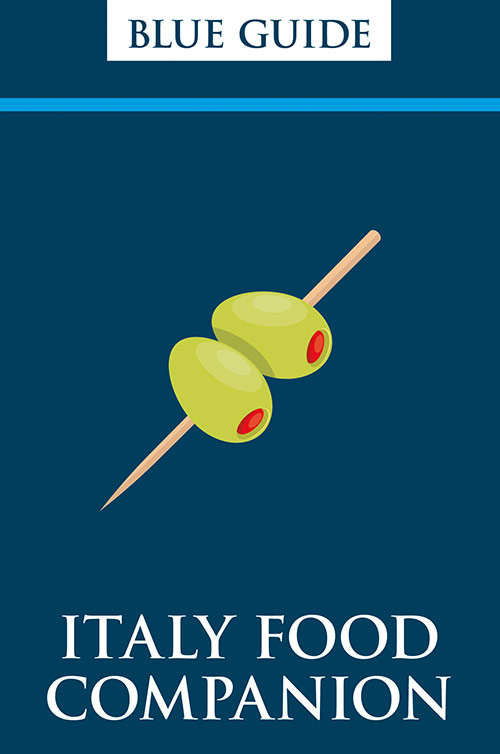
How to enjoy the best of Italian food: understand the menu and know how to order in a restaurant or street market.
View details, look inside and order securely on line direct from the publisher here »

How to enjoy the best of Italian food: understand the menu and know how to order in a restaurant or street market.
View details, look inside and order securely on line direct from the publisher here »
In 1900 the archaeologist Giacomo Boni uncovered some intriguing remains in the Roman Forum: those of the so-called ‘Oratory of the Forty Martyrs’ and, leading off it, a covered brick ramp. These remains are usually closed to the public, and work on them is ongoing, but at the moment (until 10th January 2016) they are open as part of an exhibition.
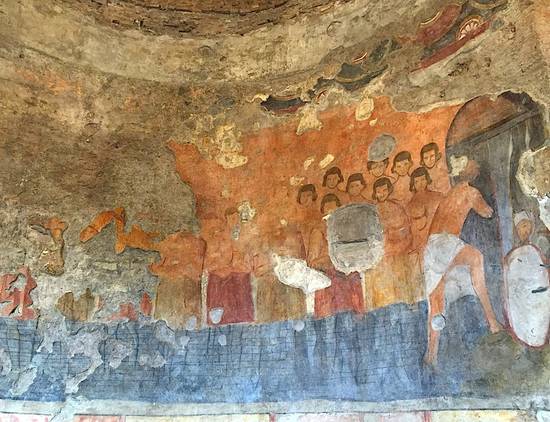
From the street which runs alongside what would once have been the entrance portico of the great Basilica Julia (an opposite the modern public toilets), a path leads to the excavations. The Oratory, its walls covered in fragmentary frescoes, has been enlosed by a modern roof, walls and door. At first sight, you might think there is nothing remarkable about these, but signboards explain the enormous trouble that has been taken to reconstruct what might originally have been in place here: a roof which rises above the ground at the same height as the ceiling of the ramp, a door whose dimensions conform to those of ‘Golden Rectangle’, and an interior volume that, like that of the Pantheon, is exactly as tall as it is wide, so that a perfect sphere could be fitted inside. The room itself, today known as the Oratory because of its later use as a place of Christian worship, was originally constructed in the 1st century, at the time of the emperor Domitian, to form an entrance vestibule to the ramp, the covered walkway which slopes and winds its way gently up to the Palatine Hill, linking the Imperial palace and the Forum.
The ramp and its ancillary buildings were added to by succeeding emperors so that by the time of Hadrian in the 2nd century the complex consisted of the ramp itself, two separate vestibules and a grand porticoed atrium. The current exhibition has opened the ramp and the first vestibule, the Oratory of the Forty Martyrs, to the public.
The ramp is similar in its design to that inside Castel Sant’Angelo, the ancient mausoleum of Hadrian, which winds through the core of the building to the central sepulchral chamber. It is tall and narrow and barrel-vaulted, its walls and floor made of brick. It would have been possible to travel along its length on horseback. Rooms that open off it might have been used by the Imperial guard. They have been arranged to exhibit pieces of sculpture found during excavations. At the level of the first landing, on the right, are the remains of a latrine, built during the time of Hadrian and close to a staircase inserted under Hadrian’s predecessor Trajan to link the grand atrium or forecourt to the ramp. In the early Christian era, this atrium was turned into the church of Santa Maria Antiqua, and it is known that the staircase was still in use at that time. The ramp leads onward and upward, out into the sunlight again, to an elevated terrace from where there is a magnificent view of the Forum down below and across the rooftops, domes and bell-towers of the city. The continuation of the ramp from here to the summit of the Palatine is not open, and indeed excavations are not yet complete. It is proposed at a later stage to open it up and allow public access.
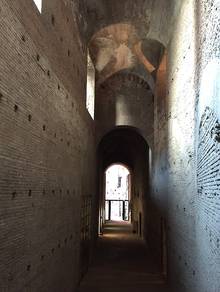
The Oratory of the Forty Martyrs has interesting traces of fresco decoration. Each of the four walls was decorated with a dado of trompe l’oeil white drapery, above which are figurative scenes. On the wall on the left as you enter (the north wall) are the very scanty remains of the Forty Martyrs in Glory. You can still make out some of their heads, encircled with haloes, and their bright white robes, edged with purple like a magistrate’s toga. The east wall, with an apse at its centre, has the main scene. The Forty Martyrs were Roman soldiers of the Legio XII Fulminata, who had converted to Christianity. They were sentenced (in AD 320) to spend the night naked in a frozen pond, near which were warm baths, specially prepared to tempt any who might wish to recant rather than die of exposure. One of the company did so: the fresco shows him sneaking away from his companions to thaw his frozen limbs. His action left only thirty-nine faithful, until one of their guards came forward and confessed his Christian faith, taking the number back to forty again. To the left of this scene are large painted crosses, hung with jewels, and below one of them, a peacock, symbol of immortality. The south wall had scenes of monastic life (very ruined). The frescoes have undergone several restorations between 1969 and today. For this exhibition, they were restored (very beautifully) under the leadership of Susanna Sarmati.
by Annabel Barber. See here for Blue Guides on Rome.
We came to Sabbioneta the small Renaissance city brought to its final form by Vespasiano Gonzaga in 1590, in the spring of 2015 to check it as a possible stop on a tour. Despite its World Heritage status, Sabbioneta is still little visited; we were almost alone as we explored its buildings and walked around its walls. Yet it is fascinating in itself as a time capsule of late 16th-century architecture, above all in the exquisite theatre, just a few years later than Palladio’s Teatro Olimpico in Vicenza but echoing it in style. It came as no surprise to find that it is the work of Vincenzo Scamozzi, who had finished Palladio’s masterpiece after his death.
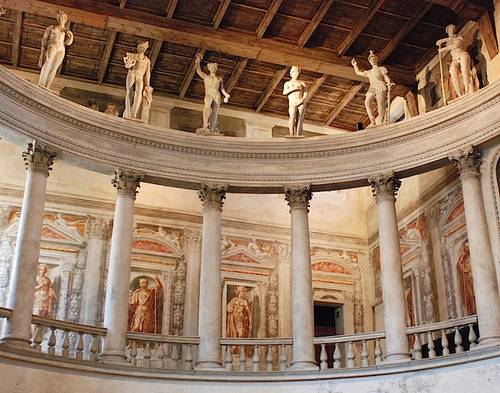
The architect James Madge, who died in 2006, first visited Sabbioneta in January 1988, a day on which the fog of the Lombardy plain enveloped the city. As he walked around, buildings loomed from the mist and then disappeared, perspectives came and went, the length of the Galleria Grande seemed to merge into nothingness. It gave him the sense that there was more to Gonzaga’s creation than simply ‘the ideal city’ and he became fascinated by Vespasiano Gonzaga himself, ‘for whom architecture was a means to externalise a complex, often contradictory and passionate nature’. Why was Vespasiano so determined to create this small (probably no more than 2,000 citizens), idealised city in a comparatively remote spot on the banks of the Po?
The result of Madge’s researches are Sabbioneta, Cryptic City, published by Biblioteque McLean (London, 2011). Madge begins by tracing Vespasiano’s background. His father had died when Vespasiano was only eleven months old, leaving the township of Sabbioneta as part of his inheritance. This was only a cadet branch of the family. Vespasiano was never to enjoy the wealth of his cousin Guglielmo, the head of the Gonzaga family in Mantua, with his thousand dependents and twenty residences, but his mother was from the ancient Colonna family and Vespasiano was profoundly conscious of his status as one of noble heritage and status. He was lucky to be brought up in the household of his aunt Giulia Gonzaga, a childless window of great learning who ensured he had the best education in the classics.
He was then sent off to the court of his uncle, Philip II of Spain. Perhaps it was because as an Italian he would always be an outsider, perhaps the hothouse aristocratic atmosphere of Philip’s court would have stifled anyone who was not exceptional, but Vespasiano’s achievements in Spain were always modest. There were some reckless charges in battle which he was lucky to survive, and he proved a capable diplomat, but lacked the éclat or presence to go further. His most senior posting, as Viceroy of Navarre, appears to have been largely honorary.
There were also problems in his intimate relationships. His first marriage proved childless and he was alienated from his wife: there were rumours of her infidelities. His second marriage, to the Spanish Anna of Aragon, did produce a daughter, Isabella, and a son, Luigi, but Anna appears to have suffered from deep depression and had withdrawn from Vespasiano’s life years before her death. Now came the tragedy of his life. Luigi, always sickly, died while still a boy, a terrible blow for a father who was so conscious of his noble heritage. A third marriage, conceived in desperation in the last hope of providing an heir, was childless. The Gonzaga-Colonna line was due for extinction. Madge analyses the poems that Vespasiano left. They were hardly of great quality but show him as solitary and unfulfilled, the women he addresses hopelessly idealised.
So this perhaps helps explain the impetus for a semi-private world of his own creation, a place where Vespasiano could act out the role of cultured humanist. Sabbioneta was a lifelong project, with its founder escaping when he could from his duties in Spain. He began in 1556 by creating a community from the existing township that he had inherited. Citizens would lose their privileges if they did not reside there, absentee clergy were summoned back to their parishes, a monastery was relocated within the walls and no local market was to be held outside the central piazza. Madge notes how the inhabitants soon took pride in the new town that was rising around them and their loyalty was reinforced by the benevolent rule of their patron. Vespasiano’s tolerance extended to a community of Jews, rare at a time when the Counter-Reformation was gathering strength (one can still visit the city’s synagogue). Though he kept his religious beliefs to himself, his range of contacts showed he was never closed to religious diversity.
This is not a guidebook to Sabbioneta, although Madge uses his architectural experience to trace some of the influences from the treatises of Leon Battista Alberti (whose masterpiece of Sant’Andrea in Mantua is not far away) and, through Alberti, back to the Roman architect Vitruvius. Vespasiano was steeped in the Roman world. He had himself presented as a Roman in the fine bronze statue of him by Leone Leoni (1588), originally outside the ducal palace but now crowning his tomb in the church of the Incoronata. Rome, as Madge puts it, ‘is immanent as a felt presence at Sabbioneta’. The city is aligned on an axis that leads southwards to the city, there are frescoes in the theatre of Rome as it was in Vespasiano’s day and his own seat there is placed in front of a fresco of his namesake, the emperor Vespasian.
Unlike Palladio’s Teatro Olimpico, the theatre in Sabbioneta is conceived as an independent building, probably the first of its kind. With its statues of the Olympian gods, frescoes of the emperors and of Rome, and a painted loggia of local figures (reminiscent of the Veronese’s frescoes from the Villa Barbaro), it is a wonderful place to visit. Nearby the Palazzo Ducale (Vespasiano was created Duke of Sabbioneta by the emperor Rudolf II in 1577) has much of interest, but perhaps one comes closest to Vespasiano himself in the private apartments of the Palazzo del Giardino. The frescoes here, by Bernardino Campi, show his fascination with Roman literature: there are scenes from the Aeneid and mythology from Ovid’s Metamorphoses. Madge attempts to make connections between the preoccupations of Vespasiano and the subjects of the frescoes but it could equally be said that these are typical expressions of the 16th-century humanism. What is special is the Galleria Grande, 96m long. Originally Vespasiano’s collection of antique statues were spaced along the walls, but towards the end of his life, he took out the busts of famous commanders and refilled their niches with antlers and other ‘natural’ objects that he had acquired while visiting his patron, the emperor Rudolf in Prague. It shows that, even in his last years, Vespasiano was still intellectually inquisitive.
The theatre was inaugurated in February 1590 during carnival celebrations and a troupe of comedy players was based there over the following months. However, Vespasiano was ailing and he died in 1591, leaving the city to his daughter and her husband. Over the years that followed the city stagnated. The statues went to Mantua in the 18th century. The theatre passed from granary to warehouse, from barracks to the local cinema, before its restoration in the 1950s.
Meticulous readers will note that James Madge died in 2006 and Sabbionetawas not published until 2011. It is good that the book was rescued for publication, although the material, particularly that on Vespasiano’s life, might have been reorganised in a better chronological sequence. In his attempt to find the roots of Vespasiano’s personality, Freud is brought in to help, but it is hard to isolate Vespasiano’s inner traumas from the wider world in which he lived. In so many ways he represented the cultural elite of his day: tolerant, well-read, half-lost in the Classical world. Where this book has wider appeal lies in the generous selection of 16th-century humanist texts that Madge has brought together. Sadly the illustrations at the end are rather cramped but overall Madge does well to give an interpretation of Sabbioneta that explains why it came to be.
Reviewed by Charles Freeman, historical consultant to the Blue Guides.
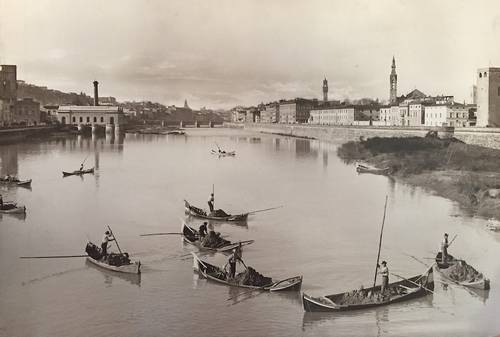
Almost the first house you come to on the peaceful Lungarno Soderini (which skirts the Arno as it flows downstream away from the centre of Florence) is the Museo Bellini, in a charming small building designed at the turn of the last century by the eccentric architect Gino Coppedè for Luigi Bellini, the most famous collector and antiquarian in a family still dedicated to this activity (and who still live here). A wisteria in the garden climbs all the way along the front across the little balcony. It was built specifically to house the Bellini collection, put together by generations of the family since the mid-18th century (and is connected to their residence by a spiral stair). The interior is filled with many precious works of art: paintings and sculptures; genuine, unrestored 15th- and 16th-century furniture; majolica and works by the Della Robbia, and small bronzes. The present Luigi Bellini tells of travels in Italy with his father when just a young child: while waiting outside a house while a transaction was underway he would open his bag and play with the small bronzes he found there.
The property is much larger than it appears from the river front: it stretches all the way back to Borgo San Frediano, and the rooms get older as the property recedes. The oldest part, Palazzo Soderini, dates from the 15th century or even earlier.
The atmosphere is unforgettable and it seems almost superfluous to name some of the treasures, or to be too fussy over the attributions (perhaps sometimes over-ambitious) and dates. But to give an idea of the diversity, there are paintings by Bronzino, Suttermans, Luca Carnevalis (a view of Venice), Guidoriccio Cozzarelli (two gold-ground panels with saints), and even a little private altar of the Madonna with the standing Child attributed to Fra’ Angelico (the doors of the tabernacle are opened for you). But it is perhaps the Cupid and Psyche, thought to be by Rubens, which is the most striking painting of all. The painted wood sculpture includes two beautiful pieces by Francesco da Valdambrino, and there is a splendid collection of small Renaissance bronzes (some of them charmingly displayed in a 16th-century sacristy cupboard). There is also a painted papier-mâché bust of a female saint showing affinities with Donatello and a female bust in wood (which still has its real lace bonnet intact) probably by Neroccio di Bartolomeo Landi (this, together with other pieces, was purchased in an early 20th-century sale at Palazzo Davanzati). A very fine polychrome stucco bas-relief of the Deposition is given to the hand of Bandinelli. The majolica comes from the best known manufactories in Italy and there is very rare early Hispano-Moresque lustreware.
The rooms are dimly lit, some of the walls lined with velvet, others with lovely tapestries, and there are worn carpets underfoot. The atmosphere is that of a treasure-trove of other days when collecting was an art performed by connoisseurs who, one feels, surely purchased objects for their intrinsic beauty rather than their monetary value.
NB: Visits to the museum are by previous appointment. T: 055 214031
or contact through www.bellinmuseum.org.
After the visit it is worth continuing along the Lungarno as far as the piazza in front of the church of San Frediano in Cestello (open 9.30–11.30 & 5-6.30): after rain the sound of the waters of the Arno as they flow over a dyke in the river are reflected off the bare façade. The interior is interesting for its late 17th- and early 18th-century painted decorations and a lovely polychrome wood statue of the Madonna (all described in Blue Guide Florence). From here there is a charming view of the humble houses and terraces of the district of San Frediano in the Oltrarno.
by Alta Macadam. Alta is the author of many Blue Guides to Italy. She is currently working on a new edition of Blue Guide Rome.
Albania, largely a Muslim country during the long Ottoman occupation, albeit with Christian and Jewish minorities, became an officially atheist state in 1967. The practice of any form of any religion was banned, cultic buildings were either destroyed or simply abandoned and allowed to crumble. In the early 1990s, during the turmoil that shook the Balkans and, further east, the Soviet Union, Albania came out of its seclusion, rekindling contacts with the West. Many people left the country in search of a better life abroad. The ban on religion was lifted but with no dramatic results. Twenty odd years of enforced atheism seemed to have smothered any feelings in that direction. Albanian society today can be described as largely secular. Sparsely dotted here and there, one can see old buildings with new crosses, replacements of those taken down; old mosques that have been restored; and a few new structures. The dearth of synagogues may be due to the flight of the Jewish community to Israel. On the whole, religious practice is very muted. Church bells, with their distinctive dry and sharp sound are rarely heard, muezzins seem to call the faithful only twice a day and even then their call is low key, almost apologetic and only lasts a couple of sentences. Not all villages have a mosque or a church: they are altogether pretty thin on the ground.
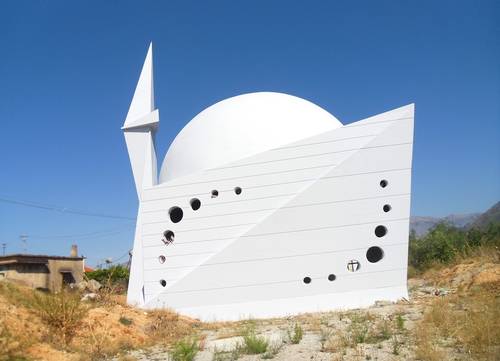
In the south, in the hinterland on a secondary road to Delvina from Saranda, in a small village that has no name since the practice of road signing is still in its infancy (adding an extra challenge to driving), is the mosque in the picture. It sits by the road and cannot be missed. It is not yet finished and the interior is still full of bags of cement while the surroundings need landscaping and a fountain for ritual ablutions. The style is interesting, though: it is new for Albania and for mosques in general. Other buildings of this sort tend to be rectangular and rather squat, with a dome covered in shiny material and a pencil minaret. They conform to a type that one can see in Turkey, for instance. Indeed, some of the new Albanian mosques are the bequests of the Turkish people. This one, with its stark outside, daring lines and imaginative architecture, is truly a departure from the standard model. It is small but better proportioned. The blue sky of the August sun (when the picture was taken) makes a wonderful background. The crooked minaret, asymmetric dome and new style windows are arresting. It will be interesting to see how the light plays inside. Albania has not been particularly noted for its architecture. Now, at long last, it is putting its name on the map.
by Paola Pugsley, author of Blue Guide Crete and three Blue Guide e-chapters on Turkey. A fourth, covering Central Anatolia, is in production. For the special reprint edition of Blue Guide Albania & Kosovo, see here.